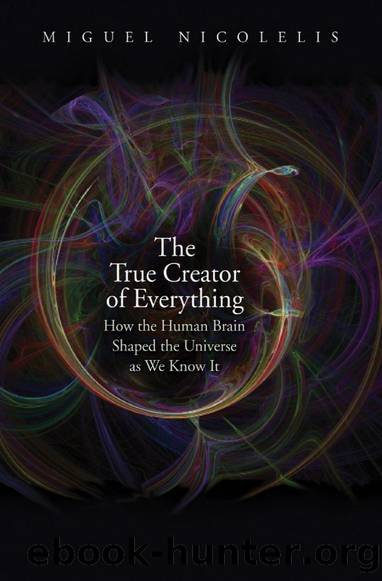The True Creator of Everything: How the Human Brain Shaped the Universe as We Know It by Miguel Nicolelis

Author:Miguel Nicolelis [Nicolelis, Miguel]
Language: eng
Format: epub
ISBN: 9780300248883
Published: 2020-06-06T10:53:03+00:00
9 ⢠Building a Universe with Space,
Time, and Mathematics
One winter morning sometime in the early 1300s, as the fi rst dim sunlight tinged the frigid Swiss skies, revealing a rose-fi ngered dawn worthy of a Greek poem, the village of Saint Gallen, built around the stone walls of the iconic Saint Gall monastery erected by the Benedictine order in the eighth century, was about to fi nd its last collective sleep cycle of the night abruptly interrupted yet again. As had happened for a while, every morning the inhabitants of that typical medieval community were taken away from their sweet dreams and warm beds by a sound that had changed their lives forever. As the immense iron bells in the monasteryâs towers began to toll, announcing the arrival of the fi rst of the seven canonical hours of the dayâknown as matins, or daybreakâevery brain touched by that holy sound wave once again became entrained as part of a well-synchronized brainet.
In accordance with the seventh-century bull of Pope Sabinianus, who instituted the tradition of canonical hours, during the next twenty-four hours the bells of the monastery would produce the same intimidating sound six more times (prime, at 6 a.m.; terce, at around 9 a.m.; sext, around noon; nones, around 3 p.m.; evensong or vespers, early evening; and compline, just before bed), reinforcing the irreversible grip the bells had acquired over those fourteenth-century human brains by dictating their daily routine. Since the practice had become law, one woke at 6 a.m. (at the prime hour), ate lunch at noon (at the sext), dined, and went to bed, all following the monastery bellsâ
commands. And as this practice took hold of life around the Benedictinesâ
stone walls, at each bell tolling, the villagersâ brains were sure to remind their owners that time had ceased to be experienced as a continuous phenomenon, 189
Y7643-Nicholelis.indb 189
9/20/19 7:26 AM
190 sp a c e ,
t i m e , a n d m a t h e m a t i c s
stretching fl uidly from dawn to dusk without punctuation or meaningâ
simply fl owing at the will of the rhythms of the natural world, its seasons and humors.
With the advent of the canonical hoursâand later of the mechanical clock, which soon found its way to the same medieval monasteryâs towersâa new rulerâman-made discrete timeâtook over the daily living schedule, subjugating even the innate natural cadence of the human biological circadian rhythms. Although it wasnât until 1345 that a consensus emerged to divide an hour into sixty minutes and a minute into sixty seconds, the impact of time-dispensing on the way people thought, behaved, and lived was immense.
Time-dispensing by medieval monasteries was a life-changing event, creating a new sense of order and further enhancing the regimental aspects of human life by imposing, quite artifi cially, what Lewis Mumford named âthe regular collective beat and rhythm of the machine.â Resonating with the central theme that informs my own view of how human brainets are established and account for powerful social
Download
This site does not store any files on its server. We only index and link to content provided by other sites. Please contact the content providers to delete copyright contents if any and email us, we'll remove relevant links or contents immediately.
Rewire Your Anxious Brain by Catherine M. Pittman(18551)
Talking to Strangers by Malcolm Gladwell(13222)
The Art of Thinking Clearly by Rolf Dobelli(10213)
Mindhunter: Inside the FBI's Elite Serial Crime Unit by John E. Douglas & Mark Olshaker(9186)
Becoming Supernatural by Dr. Joe Dispenza(8119)
Change Your Questions, Change Your Life by Marilee Adams(7634)
Nudge - Improving Decisions about Health, Wealth, and Happiness by Thaler Sunstein(7615)
The Road Less Traveled by M. Scott Peck(7522)
The Lost Art of Listening by Michael P. Nichols(7403)
Enlightenment Now: The Case for Reason, Science, Humanism, and Progress by Steven Pinker(7228)
Mastermind: How to Think Like Sherlock Holmes by Maria Konnikova(7223)
Win Bigly by Scott Adams(7094)
The Way of Zen by Alan W. Watts(6504)
Daring Greatly by Brene Brown(6443)
Big Magic: Creative Living Beyond Fear by Elizabeth Gilbert(5610)
Grit by Angela Duckworth(5512)
Ego Is the Enemy by Ryan Holiday(5292)
Men In Love by Nancy Friday(5155)
Altered Sensations by David Pantalony(5043)
